Discover the Top 15 World’s Most Spectacular Waterfalls: The Ultimate Traveler’s Bucket List
- March 29, 2024
- 0 comment
Discover the top 15 World’s Most Spectacular Waterfalls. Perfect for travelers looking to explore nature’s most stunning sights. Waterfalls are some of the most amazing sights in nature, and there’s a whole world of them out there waiting to be explored. In this guide, we’ll take you through the top 15 waterfalls that everyone should visit at least once. These aren’t just any waterfalls; they are the most beautiful ones you’ll find anywhere, from huge, roaring falls to quiet, hidden gems. This list is your ticket to adventure and seeing the incredible beauty of water in motion.
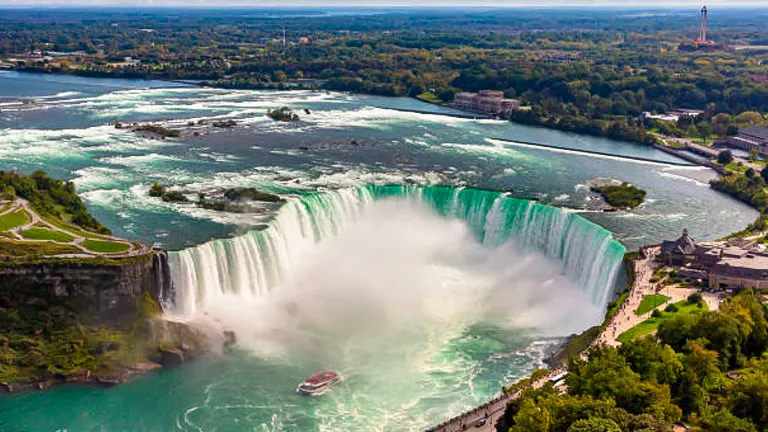
Whether you love exploring new places or just enjoy seeing beautiful photos, these waterfalls are sure to impress. So, let’s get ready to add some amazing spots to your travel bucket list and experience the best of what nature has to offer.
List of Top 15 World’s Most Spectacular Waterfalls
- Niagara Falls
- Iguazu Falls
- Victoria Falls
- Angel Falls
- Gullfoss “Golden Falls”
- Plitvice Lakes National Park Waterfalls
- Kaieteur Falls
- Yosemite Falls
- Ban Gioc–Detian Falls
- Skógafoss
- Tugela Falls
- Rhine Falls
- Havasu Falls
- Dettifoss
- Jim Jim Falls
The Majesty of Waterfalls: Understanding Their Appeal
Waterfalls captivate us with their sheer size, the sound of crashing water, and the ability to witness the power of nature’s elements combined. They serve as a reminder of the earth’s past, present, and future, continuously shaped by water and time. Visiting these natural wonders offers not just a feast for the eyes but a profound sense of connection with the natural world.
Top 15 World’s Most Spectacular Waterfalls
1. Niagara Falls, USA/Canada
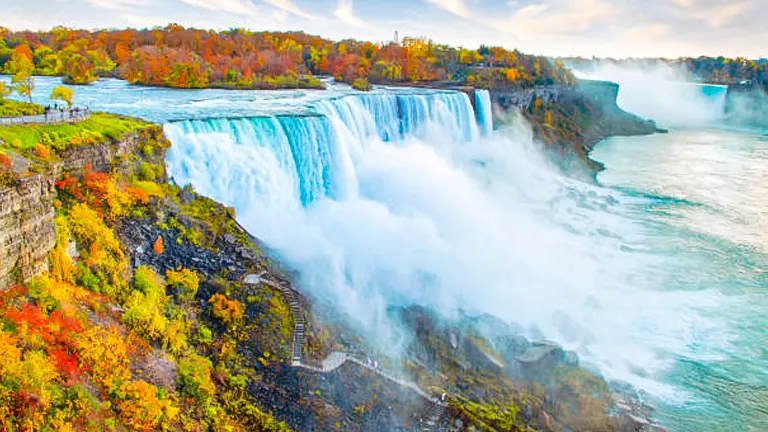
Niagara Falls comprises three powerful waterfalls on the Niagara River, straddling the border between Ontario, Canada, and New York, USA. Known for their accessible beauty and significant hydroelectric power, these falls are a monumental natural attraction.
- Best Time to Visit: June to August for warmer weather and full tourist services.
- Specific Size: Horseshoe Falls drops about 57 meters (187 ft) with a width of 790 meters (2,590 ft).
- Visitor Tips: Enjoy the Maid of the Mist boat tour or the Journey Behind the Falls for a close encounter.
- Special Features: The nightly illumination of the falls and seasonal fireworks offer spectacular views.
- How to Get There: Niagara Falls is easily accessible by car or public transportation from major cities like Toronto in Canada and Buffalo in New York, USA. The nearest airports are Buffalo Niagara International Airport (USA) and Toronto Pearson International Airport (Canada).
2. Iguazu Falls, Argentina/Brazil
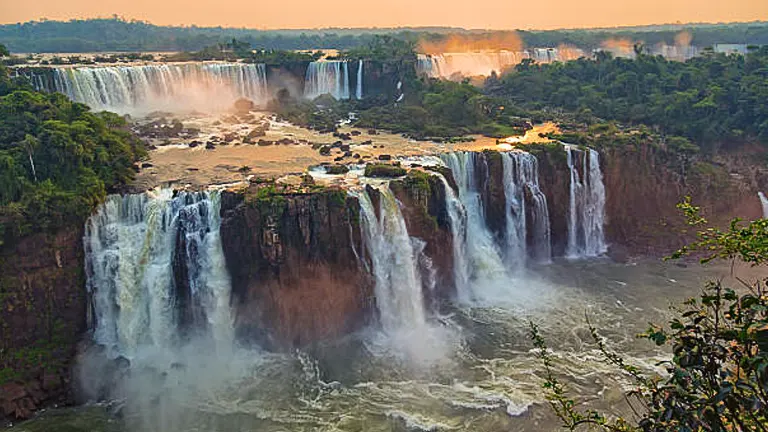
Iguazu Falls, nestled within the Iguazu National Park, forms one of the largest waterfall systems in the world. The falls are famous for their panoramic beauty, surrounded by lush subtropical rainforest which is home to a diverse range of wildlife.
- Best Time to Visit: May to September for less rain and more comfortable access.
- Specific Size: The system spans 2.7 kilometers (1.7 miles) with the Devil’s Throat being the most majestic drop of 80 meters (262 ft).
- Visitor Tips: Walking the extensive network of trails or taking a boat trip offers an immersive experience.
- Special Features: The surrounding park’s biodiversity, including unique flora and fauna, enhances the visit.
- How to Get There: Fly into Cataratas del Iguazú International Airport (Argentina) or Foz do Iguaçu International Airport (Brazil). Both sides of the falls are well-connected by bus and taxi services.
3. Victoria Falls, Zambia/Zimbabwe
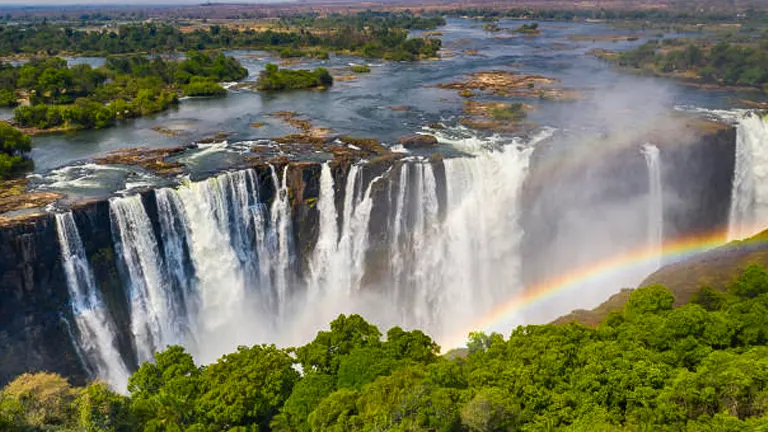
Victoria Falls, or “Mosi-oa-Tunya,” presents a magnificent curtain of water plunging into a narrow gorge. Located on the Zambezi River, it’s one of the largest and most famous waterfalls in the world, known for its thunderous sound and the mist that rises high above the gorge.
- Best Time to Visit: February to May right after the region’s rainy season for the most impressive volume of water.
- Specific Size: The falls stretch 1.7 kilometers (1.05 miles) wide with a height of 108 meters (354 ft).
- Visitor Tips: Viewing the falls from both the Zambian and Zimbabwean sides offers complete perspectives.
- Special Features: The unique phenomenon of the “Moonbow,” a lunar rainbow, can be observed on full moon nights.
- How to Get There: Victoria Falls is accessible by plane via Victoria Falls Airport in Zimbabwe or Harry Mwanga Nkumbula International Airport in Zambia. Shuttle services, taxis, and tours are available from both airports.
4. Angel Falls, Venezuela

Angel Falls is the world’s highest uninterrupted waterfall, with water cascading down 979 meters (3,212 ft) from Auyán-tepui mountain in Canaima National Park. This waterfall is not only notable for its extraordinary height but also for its remote, pristine setting in the heart of Venezuela’s jungle.
- Best Time to Visit: June to December during the rainy season when the falls are most voluminous.
- Specific Size: The fall drops a staggering 979 meters (3,212 ft) with an initial plunge of 807 meters (2,648 ft).
- Visitor Tips: The falls are best reached by air due to the remote location, followed by a river trip in a dugout canoe.
- Special Features: Angel Falls is named after Jimmy Angel, a pilot who crash-landed nearby in 1937, bringing the falls to the world’s attention.
- How to Get There: The starting point is usually Ciudad Bolívar or Canaima village, reached by plane. From Canaima camp, visitors take a river trip to the base of the falls during the rainy season.
5. Gullfoss, Iceland
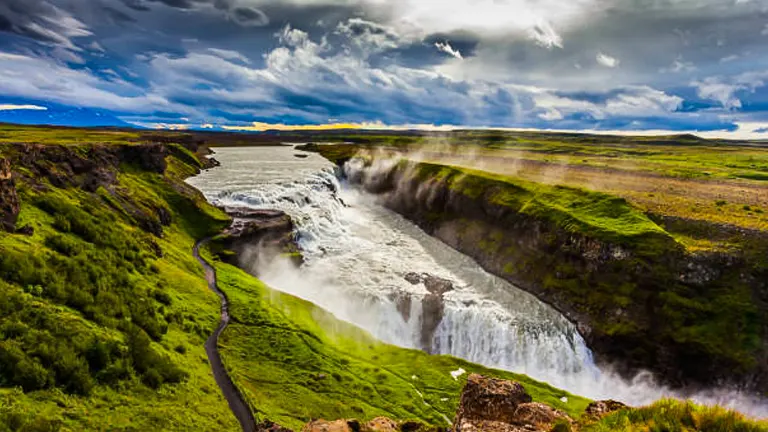
Gullfoss, or “Golden Falls,” is one of Iceland’s most iconic and beloved waterfalls, located on the Hvítá River. The waterfall descends in two stages, creating a spectacular vista set against the rugged Icelandic landscape.
- Best Time to Visit: Summer for the midnight sun and warmer weather. Winter offers the mesmerizing sight of the waterfall surrounded by ice and snow.
- Specific Size: The water falls in two stages: 11 meters (36 ft), followed by 21 meters (69 ft), into a crevice creating a total height of 32 meters (105 ft).
- Visitor Tips: The surrounding area offers numerous hiking trails for different vantage points. Be prepared for windy conditions.
- Special Features: On sunny days, the mist from the waterfall can create rainbows, adding to its beauty.
- How to Get There: Gullfoss is accessible by road and is a part of the Golden Circle tour route, about a 1.5-hour drive from Reykjavik. Rental cars and tour buses are common options.
6. Plitvice Lakes National Park Waterfalls, Croatia
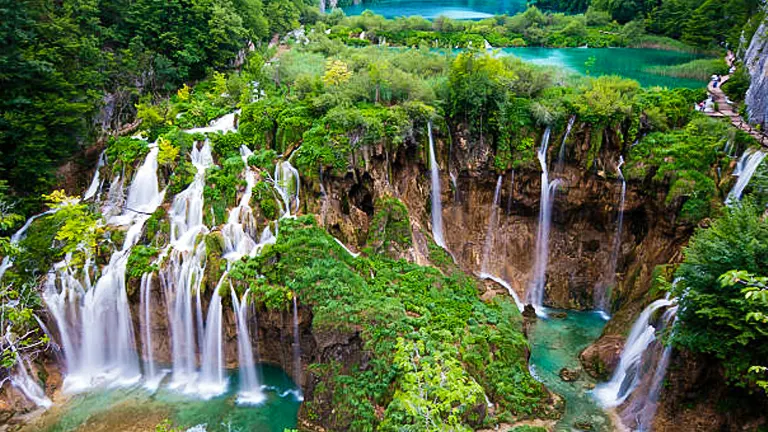
The Plitvice Lakes National Park is famed for its 16 terraced lakes connected by a series of waterfalls. This UNESCO World Heritage site showcases a unique natural phenomenon of water continuously reshaping limestone into mesmerizing cascades and pools.
- Best Time to Visit: Spring (April to June) and fall (September to October) for fewer crowds and beautiful foliage.
- Specific Size: The park features numerous waterfalls, with the largest, Veliki Slap, standing at 78 meters (256 ft).
- Visitor Tips: Follow the wooden walkways and marked trails to explore the park’s waterfalls, lakes, and lush forests.
- Special Features: The constantly changing terrain due to the calcification of the water ensures that the waterfalls and lakes are ever-evolving, presenting a new experience with each visit.
- How to Get There: The nearest major cities are Zadar and Zagreb, from where you can drive or take a bus to the park. The park has well-marked trails and boardwalks for exploration.
7. Kaieteur Falls, Guyana
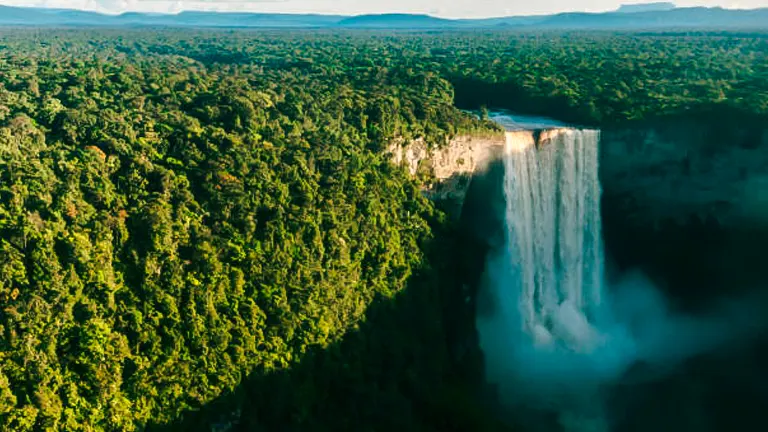
Kaieteur Falls is one of the most powerful waterfalls in the world, located on the Potaro River in the Kaieteur National Park, Guyana. This single-drop waterfall is renowned for its impressive volume of water that plunges into a deep gorge.
- Best Time to Visit: May to July during the rainy season for the most dramatic views.
- Specific Size: The fall drops 226 meters (741 ft) in a single plunge, making it about five times higher than Niagara Falls.
- Visitor Tips: Accessible primarily by small aircraft, the journey to Kaieteur Falls is an adventure in itself, offering stunning aerial views before landing.
- Special Features: The falls are in a remote part of Amazon rainforest, home to unique species such as the endangered cock-of-the-rock bird.
- How to Get There: Access is primarily by small aircraft from Georgetown, Guyana, to Kaieteur International Airport, located a short walk from the viewpoint. Tours are the most common way to visit.
8. Yosemite Falls, USA
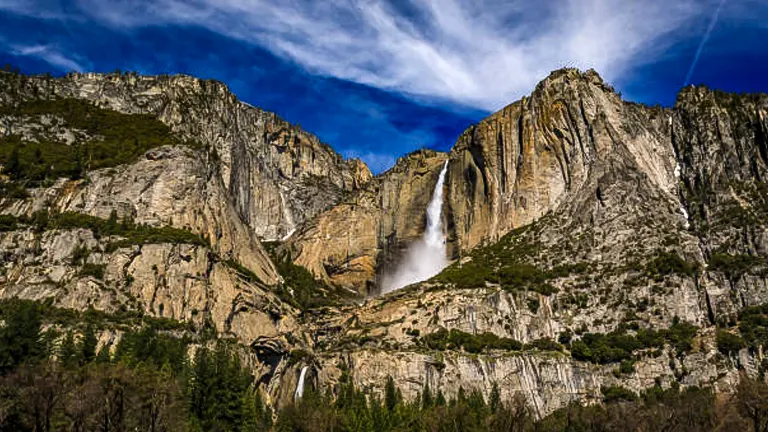
Located in California’s famed Yosemite National Park, Yosemite Falls is one of North America’s tallest waterfalls and a key attraction within the park. The falls consist of three sections: Upper Yosemite Fall, the middle cascades, and Lower Yosemite Fall, with a total drop of 2,425 feet (739 meters).
- Best Time to Visit: Late spring (April to June) when the snowmelt is at its peak.
- Specific Size: The Upper Falls alone drops 1,430 feet (436 meters).
- Visitor Tips: Hiking the Yosemite Falls Trail offers spectacular views of the falls and the Yosemite Valley. Be prepared for a strenuous hike if you aim for the top.
- Special Features: The lunar rainbow (moonbow) phenomenon is a rare sight that can be observed on clear spring nights.
- How to Get There: Located in Yosemite National Park, California, the falls are accessible by car, shuttle bus, or on foot via the park’s extensive trail system. The nearest major airports are in Fresno and San Francisco.
9. Ban Gioc–Detian Falls, Vietnam/China
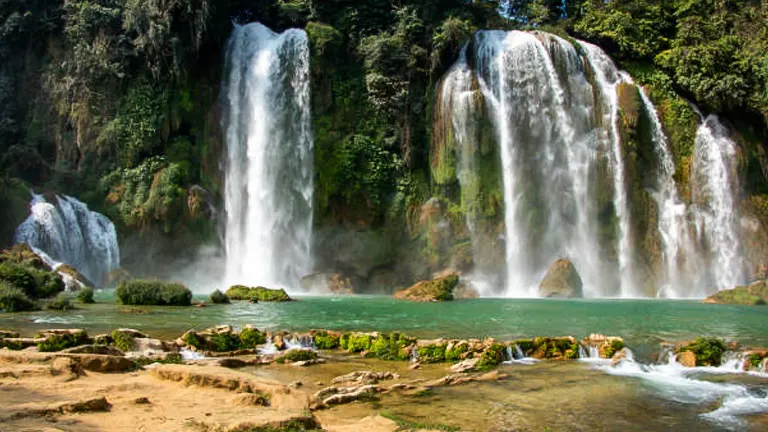
Straddling the border between Vietnam and China, the Ban Gioc–Detian Falls is a stunning transnational waterfall on the Quây Sơn River. It’s known for its picturesque multi-tiered cascades and is the fourth largest waterfall along a national border.
- Best Time to Visit: The best time to visit is during the rainy season, from May to September, when the falls are most powerful.
- Specific Size: The falls drop approximately 30 meters (98 feet) and are separated into three drops, spreading over 200 meters (656 feet) wide.
- Visitor Tips: Boat trips offer a closer view of the falls, allowing visitors to experience the mist and majesty up close.
- Special Features: The surrounding landscape is characterized by karst peaks, lush vegetation, and rice paddies, adding to the falls’ breathtaking scenery.
- How to Get There: From Hanoi, Vietnam, take a bus or drive to Cao Bằng, then continue to Trùng Khánh, where local buses and taxis can take you to the falls. Crossing from China requires proper visas.
10. Skógafoss, Iceland

One of Iceland’s biggest and most beautiful waterfalls, Skógafoss, is situated on the Skógá River in the south of the island. The waterfall is known for its impressive width and drop, creating a thunderous sound as water falls 60 meters (197 feet) to the ground below.
- Best Time to Visit: Summer for the best weather conditions and additional daylight hours. Winter visits offer the chance to see the waterfall framed by ice and snow.
- Specific Size: The waterfall is 25 meters (82 feet) wide, allowing visitors to get quite close to the base.
- Visitor Tips: Hiking up to the viewing platform at the top of the waterfall provides breathtaking views of the surrounding landscapes.
- Special Features: On sunny days, the mist created by the falls can produce single or even double rainbows, adding to its allure.
- How to Get There: Skógafoss is easily reached by car or bus from Reykjavik, located along the Ring Road in southern Iceland, making it a straightforward stop on a road trip around the country.
11. Tugela Falls, South Africa
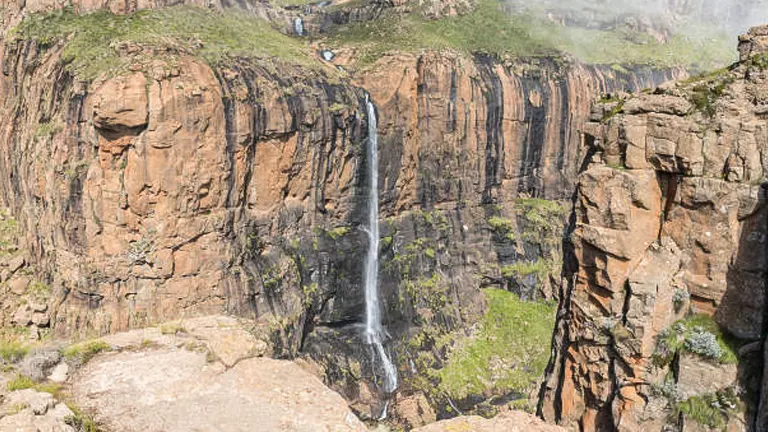
Tugela Falls, located in the Royal Natal National Park in South Africa’s KwaZulu-Natal province, is often cited as the world’s second tallest waterfall. The waterfall’s water cascades down in five free-leaping drops from the Drakensberg mountains.
- Best Time to Visit: The best time to visit is during the rainy season, from November to February, when the falls are most spectacular.
- Specific Size: The total drop in height is about 948 meters (3,110 feet).
- Visitor Tips: A challenging hike leads to the top of the falls, offering stunning views. For a less strenuous experience, there are viewpoints at the bottom that still provide impressive sights.
- Special Features: The Tugela Falls is set against the backdrop of the Drakensberg’s dramatic escarpments, making it a photographer’s paradise.
- How to Get There: The falls are located in the Royal Natal National Park in the Drakensberg Mountains. The nearest town is Bergville, with access to the park by road. The hike to the falls starts at the Tugela Gorge trailhead.
12. Rhine Falls, Switzerland
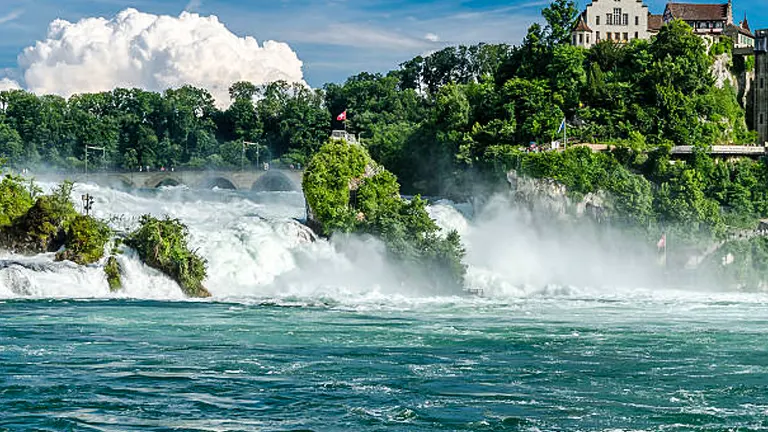
Rhine Falls, located near Schaffhausen, Switzerland, is Europe’s largest plain waterfall. This majestic natural wonder captivates visitors with its impressive width and powerful flow, especially during the summer months when the snow melts increase the water volume.
- Best Time to Visit: June to August, when the falls are most voluminous due to the melting snow from the Alps.
- Specific Size: The falls stretch over 150 meters (492 feet) wide and 23 meters (75 feet) high.
- Visitor Tips: For an up-close experience, take a boat trip to the rock in the middle of the falls. Early morning visits are recommended to avoid crowds.
- Special Features: The Laufen Castle, positioned near the falls, offers a stunning vantage point and a historical backdrop to the natural scenery.
- How to Get There: Located near the town of Schaffhausen, Rhine Falls is accessible by train or car from Zurich. A network of trails and viewing platforms allows for easy exploration.
13. Havasu Falls, USA
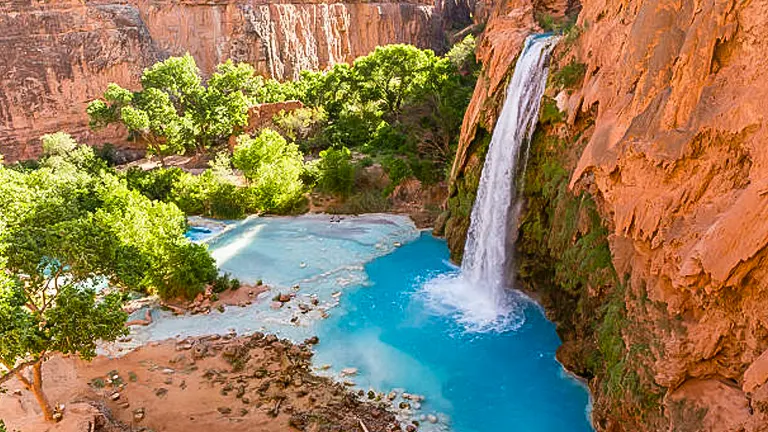
Situated in the Grand Canyon, Arizona, Havasu Falls is renowned for its striking blue-green waterfalls and the contrasting red canyon walls. Part of the Havasupai tribal lands, it offers a serene and somewhat exclusive experience due to its limited access.
- Best Time to Visit: Spring (March to May) and fall (September to November) offer ideal temperatures for hiking and enjoying the falls.
- Specific Size: The falls drop over 30 meters (98 feet) into travertine swimming pools below.
- Visitor Tips: Access requires a permit from the Havasupai Tribe, and visitors should be prepared for a 10-mile hike to reach the falls.
- Special Features: The mineral-rich water, which gives the pools their distinctive color, makes for stunning photographs and a unique swimming experience.
- How to Get There: The trailhead to Havasu Falls begins at Hualapai Hilltop, which is reachable by car. From there, it’s a 10-mile hike to the falls. Helicopter and mule services are also available but must be booked in advance.
14. Dettifoss, Iceland
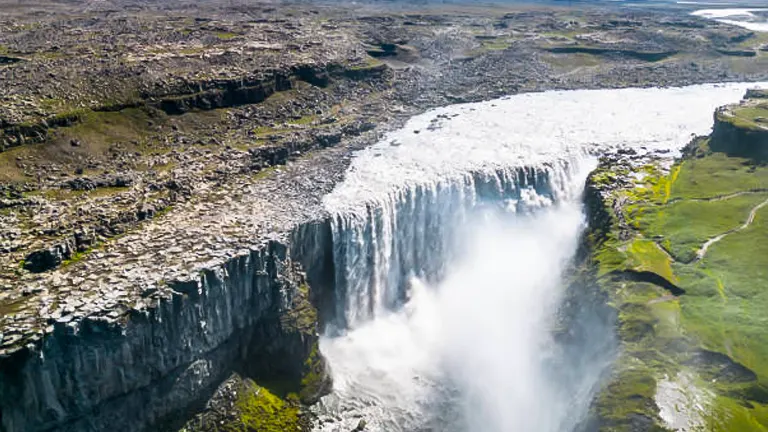
Located in Vatnajökull National Park in northeast Iceland, Dettifoss is reputed to be the most powerful waterfall in Europe, thanks to the massive volume of water that plunges over its edge every second. The falls present a raw, untouched spectacle of nature’s force.
- Best Time to Visit: The summer months of June to August offer the safest access and the fullest flow, complemented by the midnight sun.
- Specific Size: The waterfall is 100 meters (328 feet) wide and drops 44 meters (144 feet) down into the Jökulsárgljúfur canyon.
- Visitor Tips: There are viewing platforms on both sides of the falls, but the east side offers closer access to the water. Wear waterproof gear to protect against the spray.
- Special Features: The stark, lunar-like landscape around Dettifoss, part of the Diamond Circle route, adds to its otherworldly appeal.
- How to Get There: Dettifoss is located in the northeast of Iceland and is accessible via Road 862 from the west side (open year-round) or Road 864 from the east side (summer only). A visitor center and marked trails provide guidance.
15. Jim Jim Falls, Australia
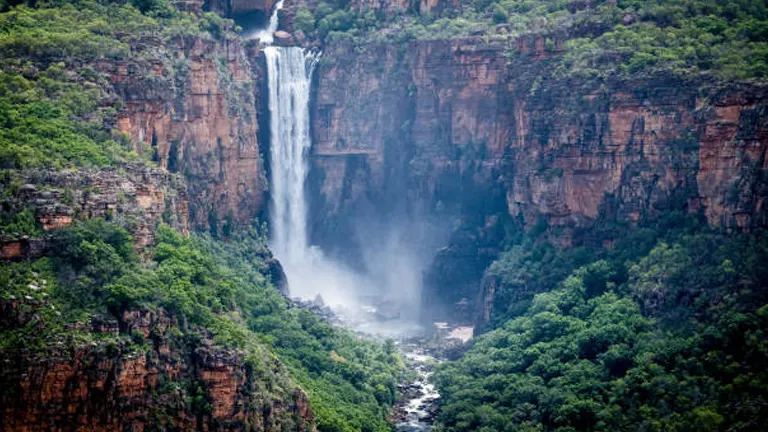
In the heart of Kakadu National Park in Australia’s Northern Territory, Jim Jim Falls is a breathtaking plunge waterfall that cascades over 200 meters (656 feet) down into a deep pool surrounded by 150-meter (492 feet) high cliffs.
- Best Time to Visit: The falls are most spectacular during the monsoon season (November to March), but access is typically by air due to flooding. The dry season (May to October) allows for ground access and the opportunity to see the surrounding stone country.
- Specific Size: The main drop of the waterfall is about 200 meters.
- Visitor Tips: 4WD vehicles are required to access the falls during the dry season, and visitors should be prepared for a rugged hike to reach the base of the falls.
- Special Features: The plunge pool at the base of the falls is a serene spot for swimming in the dry season, offering clear, cool waters surrounded by the spectacular escarpment.
- How to Get There: Located in Kakadu National Park, access to Jim Jim Falls is via 4WD on unsealed roads from Jabiru or Cooinda. The falls are most commonly visited by guided tour, which can include flights or ground transport.
Conservation and Respect
Exploring the world’s most spectacular waterfalls brings not just excitement and awe but also a responsibility. These natural wonders, while resilient, are sensitive to the impacts of tourism and climate change. As travelers, embracing responsible tourism practices ensures these sites remain unspoiled for future generations.
- Protecting Natural Habitats: Stay on designated paths and viewing platforms to minimize disturbance to the surrounding ecosystems.
- Leave No Trace: Carry out all trash and avoid using soaps or chemicals in natural pools.
- Support Local Conservation Efforts: Consider donations or volunteer work with local organizations dedicated to preserving these natural sites.
What to Do in the Area
The journey to a waterfall often takes you through some of the most scenic landscapes and offers opportunities to engage with local cultures and communities.
- Nature Trails and Hiking: Many waterfalls are part of larger national parks or natural reserves, offering extensive trails and walks through diverse habitats.
- Cultural Experiences: Engage with local communities to learn about the history and significance of the area. Many waterfalls hold cultural and spiritual significance to indigenous peoples.
- Wildlife Watching: The unique ecosystems around waterfalls are often home to a variety of wildlife, offering opportunities for bird watching and wildlife photography.
Planning Your Visit: Practical Tips for Waterfall Hunters
To make the most of your waterfall adventures, some planning and preparation can go a long way. Here are a few tips to consider:
- Check Access and Conditions: Before you go, check if the waterfall is accessible and what the current conditions are like. Some falls are seasonal or may have restricted access due to conservation efforts.
- Gear Up: Wear appropriate footwear for potentially slippery and uneven terrain. A waterproof jacket, a hat, and sunscreen are also essential for protection against the elements.
- Safety First: Always respect safety signs and barriers. Waterfalls can be dangerous, with strong currents and slippery rocks.
Conclusion
The world’s top waterfalls offer a glimpse into the raw beauty and power of nature. From the thunderous roar of Niagara Falls to the serene cascade of Kuang Si, each waterfall presents a unique spectacle and an unforgettable experience. As we explore these natural wonders, let’s do so with a sense of responsibility and wonder, preserving their beauty for generations to come. Your next adventure awaits among the mists and melodies of the earth’s most spectacular waterfalls.
FAQs
- What’s the best way to experience the soundscapes of these waterfalls?
Immersing yourself in the natural acoustics of waterfalls is best achieved early in the morning or late in the afternoon when visitor traffic is low. Consider bringing a high-quality recording device if you wish to capture the sounds, or simply allow the roar and trickle of the falls to envelop you for a meditative experience. - Can visiting waterfalls have therapeutic benefits?
Absolutely. The negative ions produced by the crashing waters of waterfalls are believed to produce biochemical reactions that increase levels of the mood chemical serotonin, helping to alleviate depression, relieve stress, and boost daytime energy. - What’s the most unexpected item I should pack for waterfall exploration?
Aside from the essentials, an ultraviolet (UV) flashlight can be fascinating for nighttime visits. Some waterfalls are home to bioluminescent organisms that glow in the dark, and a UV light can also reveal hidden fluorescent minerals in the surrounding rocks. - How can I contribute to the preservation of these natural wonders during my visit?
Participate in or donate to local conservation efforts, stick to marked trails, and minimize your ecological footprint by using eco-friendly products and packing out all trash. Sharing your experiences on social media with a conservation message can also raise awareness. - Are there waterfalls that can be explored underwater?
Yes, some waterfalls, like those in Plitvice Lakes National Park, have underwater sections accessible to divers, offering a unique perspective of the aquatic life and geological formations beneath the surface. Always check local regulations and hire a professional guide for such adventures. - What is the best season to capture waterfall photography?
The golden hours of early morning and late afternoon in the rainy season provide the best natural lighting and vibrant landscapes for photography. The increased water volume also adds to the dramatic effect, though every season has its unique charm. - Can I visit any waterfalls that are not on the typical tourist path?
Definitely. While the list includes some of the most famous waterfalls, there are hidden gems like the Tumpak Sewu Waterfall in Indonesia or the Fairy Pools in Scotland that are less crowded. Local guides can be invaluable in exploring these lesser-known sites. - What should I do if I encounter wildlife at a waterfall?
Maintain a safe distance, avoid feeding or attempting to touch the animals, and store your food securely. Observing wildlife in their natural habitat can be a thrilling part of the waterfall experience, but it’s important to respect their space and preserve the natural balance.
Explore our dedicated section on national forests and state parks to uncover hidden gems and outdoor wonders.
We’re eager to hear about your adventures exploring the world’s most breathtaking waterfalls! Share your stories, discoveries, and unforgettable experiences with us. Join our community of explorers and nature lovers, dedicated to experiencing and conserving the planet’s most spectacular waterfalls.

Benjamin Brooks
Forestry AuthorGreetings! I'm Benjamin Brooks, and my journey over the past 15 years has revolved around the fascinating realms of content creation, expertise in snow clearing, and the intricate world of lumberjacking and landscaping. What began as a simple curiosity about the natural world and heavy machinery has evolved into a passionate profession where my love for crafting words intertwines seamlessly with my lumberjacking and garden skills.




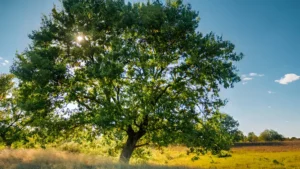








Leave your comment